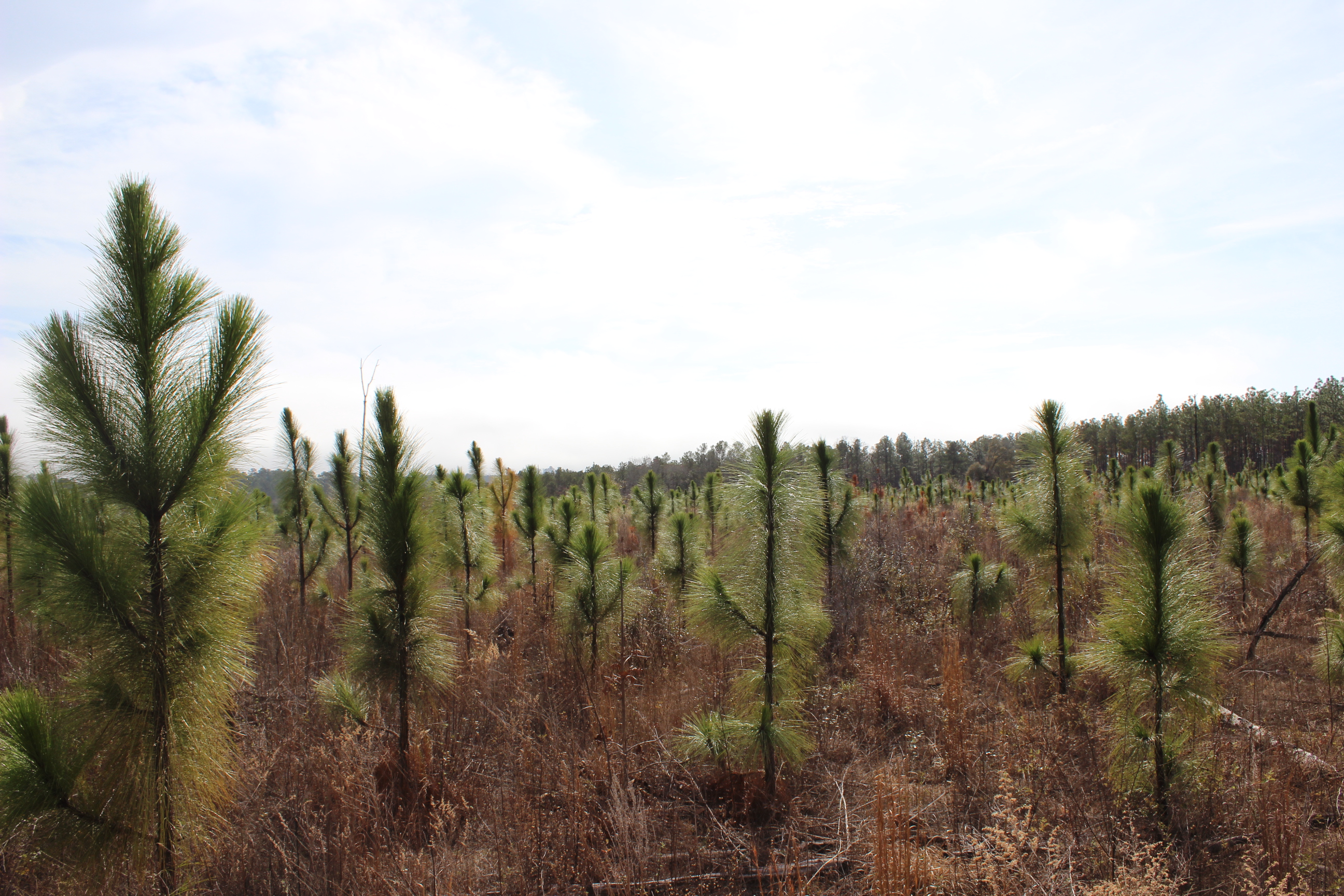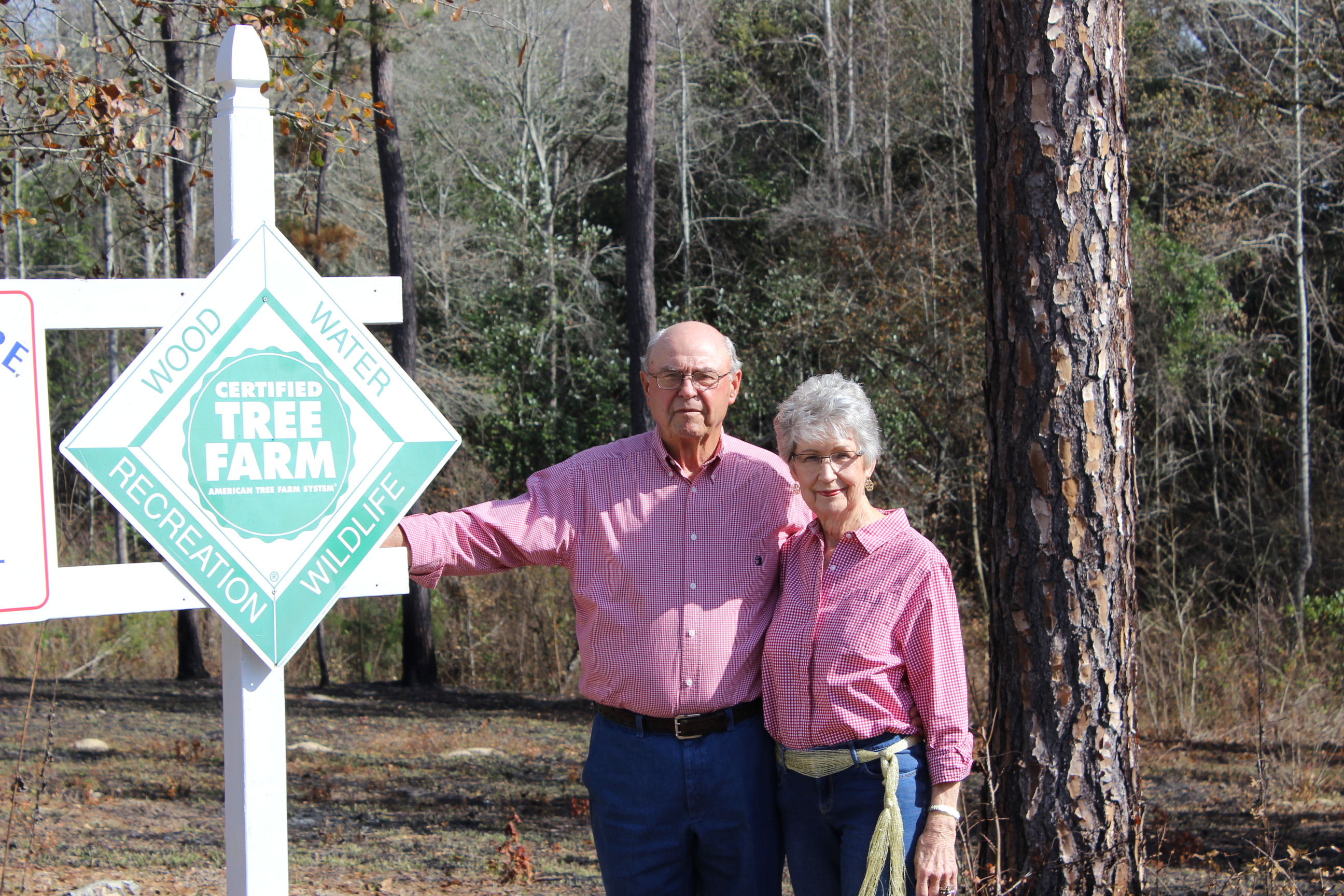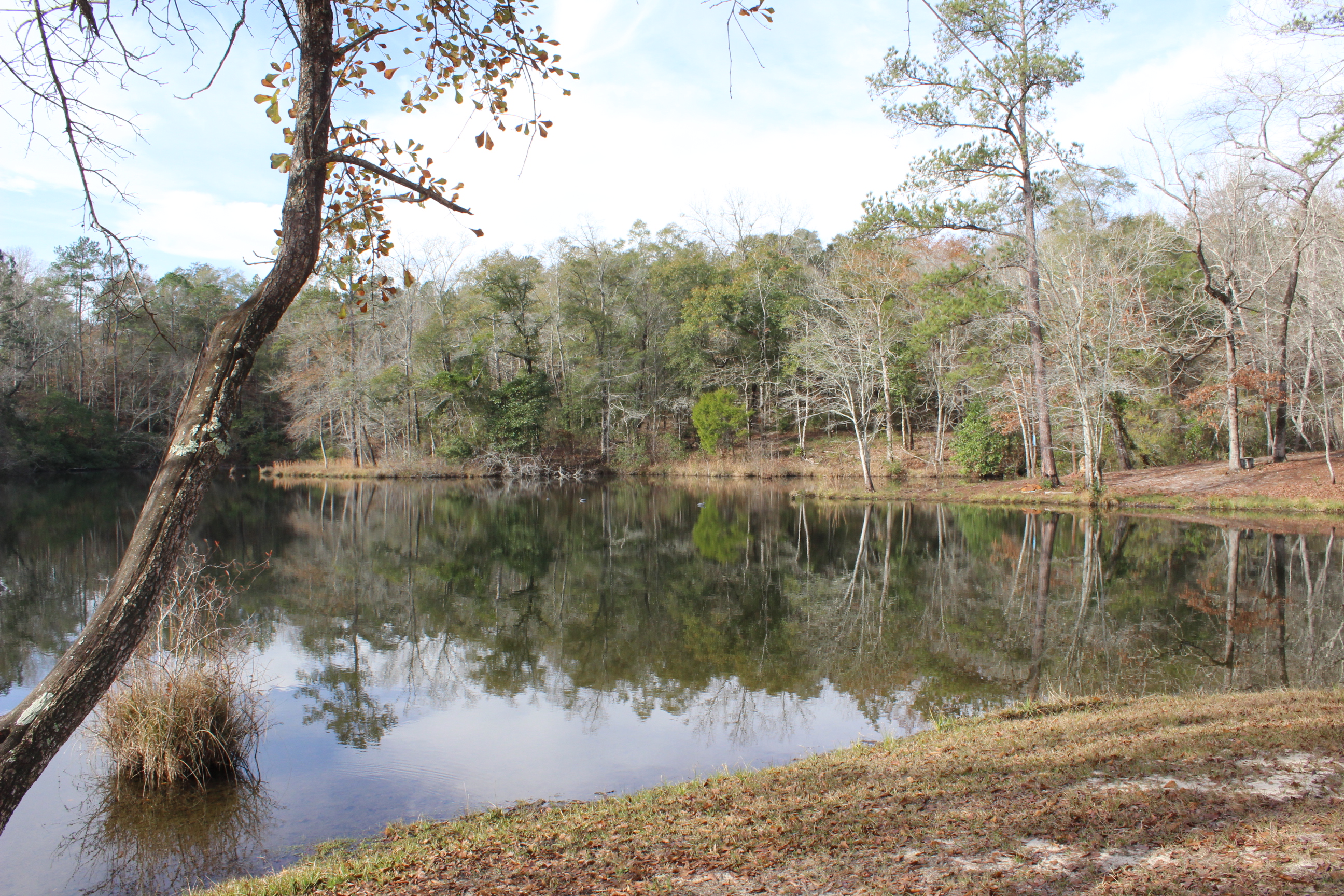Glenn and Scarlett Riley from Alabama
 What Makes Them Outstanding?
What Makes Them Outstanding?
Glenn and Scarlett Riley’s Tree Farm story is one of remembering the past and looking forward to future generations. While their management objectives include wood, water, wildlife, and recreation, their primary intent is sharing. Sharing their knowledge and resources of their Tree Farm with their family and community. Everyone from elementary students to forestry professionals has benefited from their generosity. The Riley’s have a hands on approach to management, taking on tasks such as prescribed burns and building roads. They are proud to practice sustainable forestry, benefiting both wood production and wildlife habitat. The Riley’s timber management includes uneven aged loblolly, longleaf, and bottom land hardwood. Regular prescribed burning and thinning are utilized to maintain a healthy forests. In addition to managing for game species with wildlife openings, the Riley’s also manage their property fo rnon-game species. A great example of their commitment to this includes marking all gopher tortoise burrows on the property and leaving areas open for habitat.
Stream side management zones are evident throughout the property, and the Rileys are careful to follow state BMPs when harvesting and constructing and maintaining the roads and firelanes throughout the Tree Farm.
Mr. Riley takes pride in learning all he can about sustainable forest management. He takes time to visit with forestry professionals and read publications, which has enabled him to identify and do most of his management himself. The Riley’s are a great example to other landowners, and are willing to share their knowledge and experience with all. They are a Tree Farm Family.
Tree Farmer Story
Located in East Henry County is the property of Glenn and Scarlett Riley, Alabama’s 2016 Tree Farm of the Year. The 283-acre certified Tree Farm is located in the Barnes Community and consists of planted Loblolly Pines, various ages of planted Longleaf Pines, Bottomland Hardwoods, Wildlife Openings, and a pond stocked with bass and blue gill. The Rileys enjoy sharing their property with many Henry County residents, whether they are young or old. Mr. and Mrs. Riley’s Tree Farm has been an integral part of the Classroom in the Forest Program since it began in Henry County nearly a decade ago.
Tree Farm has been an integral part of the Classroom in the Forest Program since it began in Henry County nearly a decade ago.
Glenn and Scarlet have also hosted the Forestry PLM Training program at their property, and they have been a valuable ACES and Alabama Forestry Commission partner. Their land has aided the training efforts oflocal foresters and forest industry workers. The Rileys also invite the Henry County 4-Hprogram to bring approximately 225 students to their property each year. The young people are engrossed with educational programs on wildlife and natural resources presented by Alabama Cooperative Extension System, Alabama Forestry Commission, and Alabama Department of Conservation and Natural Resources. This partnership has been fruitful and very important intraining Henry County students to conserve our natural resources for future generations. Additionally, church groups from the area attend a fall hayride on the Riley’s property and local Boy Scout troops visit the property to earn their forestry related merit badges.
One of the many features that make this area unique are the signs that are installed throughout the property. Glenn and Scarlet chose to honor their children and grandchildren by naming the roads throughout the property after their descendants. As visitors approach the intersections throughout the property, they will see wooden signs with a loved one’s namesake. In addition to providing access throughout the property, the roads also serve as firelanes to protect against wildfires and assist with prescribed burns. Another special feature of the property is the designated spiritual areas that allow Glenn and Scarlet to pray, reflect, and grow closer to God.
One area in particular is located in close proximity to a natural spring. The property owners installed a bench nearby that makes this spot the perfect place to strengthen their relationship with God. Mr. Riley spends a great deal of time on the property and has done much of the work to enhance the property independently. He maintains water diversion along his roads, and he has designated Bottomland Hardwoods as Streamside Management Zones to reduce erosion and protect water quality. Therefore, the zones are excluded from timber harvesting and prescribe burning activities. The Streamside Management Zones consist of good mast producing trees along the creeks which provide cover, travel corridors, roosting sites, and a winter food source for wildlife.
The property contains Planted Loblolly and Longleaf Pine stands that are prescribe burned every 2-3 years. Mr. Riley is able to identify and eliminate invasive species. He has treated approximately 12 - 14 acres of Kudzu over the years. Because of his efforts, the Kudzu acreage has been reduced to just a few small spots. Another area that makes Mr. Riley’s management practices exemplary are his actions to promote Gopher Tortoise habitat. For example, in one Longleaf Pine stand he has marked Gopher Tortoise burrows with stakes so that they can exist without interference from heavy equipment. Glenn and Scarlet realize that it is important to be good stewards of the land and protect it for future generations.
The couple takes pride in conserving the abundant natural resources throughout their property and are constantly seeking ways to fine tune their management techniques. Their Tree Farm is an excellent example of stewardship. It is their hope that their land will continue to be a legacy that will bring forest education, recreational enjoyment, and spiritual growth for years to come.
Wood
The land use is divided between planted Loblolly Pines, various ages of planted Longleaf Pines, Bottomland Hardwoods, Wildlife Openings, and a pond. Mr. Riley’s primary objective is to increase the income of his timber through proper forest management techniques. Mr. Riley conducted a second thinning in 2011 on approximately 80 acres of planted Loblolly and Longleaf Pines. Products harvested were pulpwood and canter wood. In 2012 Mr. Riley clearcut approximately 63 acres of planted Loblolly Pines because of beetle infestation. Mr. Riley is interested in longleaf pine and the associated native habitat it provides for various native species found on his property.
Water
Mr. Riley has designated Bottomland Hardwoods as Streamside Management Zones to reduce erosion and protect water quality. SMZs are excluded from timber harvesting and prescribe burning activities. These SMZs consists of good mast producing trees along the creeks which provide cover, travel corridors, roosting sites, and winter food source for wildlife. Mr. Riley maintains several miles of forest roads. He maintains water diversion along his roads and completes 95% of the work on his property, including roads, himself. He takes time to consult with forestry professionals as he plans out these activities, ensuring that all work is done properly to preserve water and soil quality.
Wildlife Including Threatened and Endangered Species
SMZs consists of good mast producing trees along the creeks which provide cover, travel corridors, roosting sites, and winter food source for wildlife. Hardwoods stands have been excluded from timber harvesting and prescribe burning activities in order to enhance the wildlife population. Several acres of wildlife food plots are planted and maintained annually. Mr. Riley’s management practices help promote Gopher Tortoise habitat. Not only does he manage their habitat, but he also take the time to locate and mark each gopher tortoise burrow he find on his property. These markers are easily visible, and are used keep all heavy equipment away from these sites.
Recreation and Aesthetics Including Special Sites
Mr. Riley’s secondary objectives are to enhance and maintain the wildlife population through maintaining wildlife food plots by keeping adequate cover for desired wildlife species and use the property for recreation. Pine stands have been selectively thinned as needed and prescribe burning and herbicides have been used to control undesirable competition. Hardwoods stands have been excluded from timber harvesting and prescribe burning activities in order to enhance the wildlife population and serve as a Streamside Management Zone against erosion. These SMZs consists of good mast producing trees along the creeks which provide cover, travel corridors, roosting sites, and winter food source for wildlife. Several acres of wildlife food plots are planted and maintained annually. Mr. Riley maintains several miles of forest roads. He has hosted the Henry County Classroom in the Forest for the past ten years. Church groups around the area attend a Fall hayride on the Riley’s property. Boy Scouts visit the property to complete tasks that are needed to earn their forestry merit badge. Mr. Riley has installed and maintains roads around each stand. These roads are also used as firelanes to protect from wildfires and to make prescribe burning easier. He maintains water diversion along his roads. Mr. Riley has designated Bottomland Hardwoods as Streamside Management Zones to reduce erosion and protect water quality. Planted Loblolly and Longleaf Pine stands are prescribe burned every 2-3 years. Mr. Riley has treated approximately 12-14 acres of Kudzu over the years. This Kudzu acreage has been reduced to just a few small spots. Mr. Riley’s management practices help promote Gopher Tortoise habitat.


